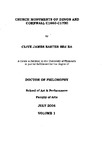Church monuments of Devon and Cornwall c1660-c1730
| dc.contributor.author | Easter, Clive James | |
| dc.contributor.other | Faculty of Arts, Humanities and Business | en_US |
| dc.date.accessioned | 2013-10-22T11:15:58Z | |
| dc.date.available | 2013-10-22T11:15:58Z | |
| dc.date.issued | 2006 | |
| dc.identifier | NOT AVAILABLE | en_US |
| dc.identifier.uri | http://hdl.handle.net/10026.1/2285 | |
| dc.description | Merged with duplicate record 10026.1/747 on 03.04.2017 by CS (TIS) | |
| dc.description.abstract |
This thesis is concerned with an analysis of church monuments in the south west peninsular counties in the period 1660-1730 and sees the monument within this region as a culturally significant object that has hitherto been largely ignored. The focus of this thesis is an analysis of the monuments themselves based on a photographic archive. This is complemented by an examination of wills and the requests for monument and other status indicators contained in those documents. The thesis also considers how the placement of the monument is an indication of social status or status pretensions and how the materials used in the manufacture of the monument also have a status dimension. Chapter 1 examines the available literature and establishes the methodology of the project. Chapter 2 looks at issues surrounding wealth and commemoration including the role of the church and the death ritual as practised at that time. Chapter 3 considers the patterns of monument distribution and also provides an analysis of the component parts of the monument. Chapter 4 focuses on the work of artists and workshops and shows that of the two major workshops working in the early seventeenth century - John Weston of Exeter and the Jewells of Barnstaple - more examples of their work have been identified as a result of this study. The chapter also looks at examples of work from artists outside the region and probable work from London yards has been identified. The final chapter looks at issues surrounding social status. The interpretations of modern authors are considered and the chapter goes on to show how status is expressed on the monument. Patterns of distribution by social status are examined and an analysis is provided of peninsular counties monuments based on social status models. | en_US |
| dc.language.iso | en | en_US |
| dc.publisher | University of Plymouth | en_US |
| dc.title | Church monuments of Devon and Cornwall c1660-c1730 | en_US |
| dc.type | Thesis | |
| dc.identifier.doi | http://dx.doi.org/10.24382/3226 |
Files in this item
This item appears in the following Collection(s)
-
01 Research Theses Main Collection
Research Theses Main



